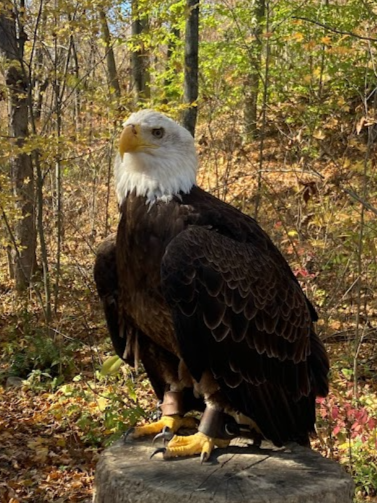
Bald Eagle
Bald Eagle
Haliaeetus leucocephalus
Listen to they how sound
Clearly recognized by its white head, brown body, and hooked yellow beak, the bald eagle has been the national emblem of the United States of America since 1782. In the wild, they usually live up to fifteen years, but in human care they can live up to fifty years old.
CONSERVATION STATUS: LEAST CONCERN
Range
Their range extends from the Mexico border through the United States and Canada. The birds are extremely populous in Alaska.
Fast Facts
-
Description
Adult Bald Eagles have completely white heads and tails with dark brown bodies and wings. Their legs and bills are bright yellow. Juveniles have darker heads and tails; their brown wings and bodies are mottled with varying amounts of white. It takes about five years to attain adult plumage.
-
Diet
In the wild, Bald Eagles are opportunistic foragers but they prefer fish as their primary food. They will also eat seabirds, ducks, rabbits, squirrels, prairie dogs, and muskrats.
-
Size
They can grow to be 2.5-3.5 feet tall with a wingspan between 5.5-8 feet long. Males weigh 6-9 lbs. while females weigh 10-15 lbs.
-
Lifespan
Wild: 20-30 years
Human care: up to 50 years
Bald Eagles’ nests are some of the largest of any bird species! These impressive nests, called eyries, can weigh up to 2,000 pounds and are often built in tall trees near water. Bald Eagles will reuse and add to their nests year after year, sometimes making them even larger over time. Some nests can be as wide as 10 feet across!
Fun Facts
Our Wildlife Ambassadors
Minco
Minco’s story began when he fell from his nest as a chick and was rescued by a rehabilitation center. Unfortunately, during his time at rehab, Minco imprinted on humans, making him non-releaseable back into the wild. Now, as an ambassador, Minco helps us raise awareness about Bald Eagles and the challenges they face in the wild while amazing guests as he soars over them. With his striking appearance and commanding presence, he’s a living testament to the importance of conservation and the incredible role these majestic birds play in our ecosystems
Minco has been at the sanctuary since 2022
Sequoia
While fledging as a young eagle, Sequoia sustained a wing injury that resulted in scar tissue on her right wing. As a result, she can only fly short distances—about 75 feet—making it impossible for her to hunt and survive in the wild. Though she can no longer take to the skies, Sequoia is a true powerhouse. Known for her impressive size and striking appearance, she captivates guests as they meet her, leaving them with an unforgetable experience.
Sequoia has been at the sanctuary since 2020




